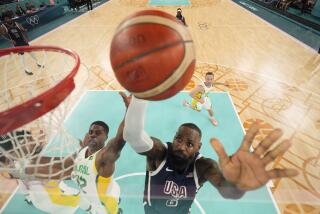Williams’ Opponents Wilt From the Glare
- Share via
PARIS — This is a look you don’t want to see if you’re on the other side of the net. It was described on French television as “hatred,” but that wasn’t exactly true.
Serena Williams looked ferocious in her French Open quarterfinal victory over Amelie Mauresmo.
She looked invincible. She looked nerveless. She looked as if there was nothing more important to her in the world than winning this tennis match, and the next and then the French Open championship.
She looked as if the opponent across the net was invisible, was nothing more than a racket and a dress. It was Amelie Mauresmo. It will be Justine Henin-Hardenne, Williams’ opponent in today’s semifinals.
It might then be second-seeded Kim Clijsters of Belgium or Russia’s 20-year-old Nadia Petrova, the 76th-ranked player who has upset Monica Seles and Jennifer Capriati and who plays 19-year-old Clijsters in today’s first semifinal.
The other women who are left in the draw are all the same to Williams. Henin-Hardenne moves with airy lightness. Clijsters uses all the court with wit and strength. And Petrova plays with the freedom of no expectations.
For Williams, it doesn’t matter. As these Grand Slam tournaments progress, as the tension for the others rises, as their nerves tingle and their strokes let them down, Williams glares at them, dares them to figure out a way to beat her.
If the crowd is against her, as it was in the quarterfinals when Williams so thoroughly dominated fifth-seeded Mauresmo that the Frenchwoman could only shrug and say, “There was nothing I could do,” all the better.
“It’s like you have to put yourself in a bubble and pretend as if nothing’s around and pretend as if you don’t hear anything and just pretend you’re the only person on that court,” Williams said.
In this bubble, Williams has played the last five Grand Slam tournaments, including this French Open. Williams will be aiming for her 34th consecutive major championship victory today against fourth-seeded Henin-Hardenne of Belgium.
She is also aiming for her fifth straight Grand Slam title, which would tie her with Steffi Graf and Monica Seles for second on the list of consecutive Grand Slam tournament winners. Graf, Martina Navratilova and Margaret Court have put together streaks of six consecutive Slam championships.
After his quarterfinal loss Tuesday, Andre Agassi spoke of the difficulties of winning a calendar-year Grand Slam, sweeping the Australian Open, French Open, Wimbledon and U.S. Open in a single season. No man has done it since Rod Laver in 1969. Laver also did it in 1962 and Don Budge in 1938. The last woman was Steffi Graf in 1988. Court swept the Slams in 1970, Maureen Connolly in 1953.
“Sports is a very honest thing,” Agassi said. “The scoreboard, it doesn’t lie. It also leaves room for incredible stories and accomplishments. To say something is not possible is a naive statement. Anything’s possible. But winning all four in one year would certainly rank up there with one of the most difficult things to do in all of sports.”
Agassi was talking about men. With the greater depth in the men’s game and the growing number of Spanish and South American men who specialize in playing on clay, it has become harder than ever for one man to excel on hard courts, grass and the Paris red clay.
Serena already has her “Serena Slam,” her victories, consecutively, in each of the majors. And Agassi says that should she complete the calendar-year Slam, it would also be an amazing accomplishment.
“What’s impressive,” Agassi said, “is how possible she makes it look. That’s what’s impressive.
“When you look at the Xs and O’s of how her game matches up to everybody else, she’s bigger, stronger, faster and hits the ball better. So it’s hard to picture her losing. The amazing thing is that you can actually say those things about one person. What she’s doing is incredibly hard. But I watch her as the rest of the world does and think, ‘Yeah, sure, she’s gonna do it.’ ”
Henin-Hardenne might have wished she had not seen any of Williams’ manhandling of Mauresmo. Williams, 21, has a 31-2 record this year. One loss came to Mauresmo in the Italian Open last month. The other, to Henin-Hardenne, ended a 21-match winning streak for Williams.
“Last time I beat her,” Henin-Hardenne said, “and I know she doesn’t like that. In a Grand Slam tournament, she is strongly determined and she wants to win.”
Understanding this is one thing. Doing something about it is another.
Serena’s sister, Venus, has been the vanquished in the finals of each of the last four Grand Slams. A disheartened Venus didn’t make it past the fourth round here and will fall to fourth in the next WTA rankings, behind Clijsters and Henin-Hardenne.
Clijsters had led Williams, 5-1, in the third set of their Australian Open semifinal and then lost. Clijsters refused to admit it was her nerves. She said it was because Williams improved her own play.
It was both.
It was Clijsters getting butterflies as she came closer to her first major championship. And it was Williams getting the look, the ferocious, invincible, nerveless look. It was Williams stepping into the ball with purpose and hitting the lines instead of the sidelines. It was Williams making the unlikely look very likely.
*
Women’s Semifinals
*--* * Serena Williams (1) vs. Justine Henin-Hardenne (4), Belgium * Nadia Petrova, Russia, vs. Kim Clijsters (2), Belgium * When: Today, 5 a.m., ESPN * Final: Saturday, 6 a.m., Ch. 4 * Head-to-head: Williams leads Henin-Hardenne, 4-2; Clijsters leads Petrova, 1-0
*--*
More to Read
Go beyond the scoreboard
Get the latest on L.A.'s teams in the daily Sports Report newsletter.
You may occasionally receive promotional content from the Los Angeles Times.










